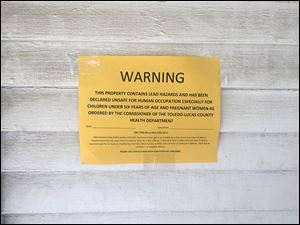
EDITORIAL
Kill that bad lead bill
10/11/2017
A placards like this one on an East Toledo home posted by Toledo-Lucas County Health Department after the Ohio Department of Health released a list of properties in the state with orders to vacate due to untreated lead hazards.
When State Rep. Derek Merrin (R., Monclova Township) failed in his attempt to kill Toledo’s pioneering lead-safe ordinance during the state budget process earlier this year, he vowed he would revive the plan in a stand-alone bill. Now he has done that, and the General Assembly should kill it just as it did his previous attempt to get rid of an important local public-health regulation.
Mr. Merrin owns investment rental properties in and around Toledo, and he complained — not when Toledo elected leaders and health officials were hammering out the measure, but months later, from his seat in Columbus — that the lead-safe measure is unfair.
Mr. Merrin’s failed budget amendment and the stand-alone bill he has since proposed would nullify Toledo’s ordinance and make such lead-related health regulation the responsibility of the Ohio Department of Health, which doesn’t have lead-safe measures like Toledo’s.
Click here to view more Blade editorials
Toledo’s ordinance — which doesn’t require lead abatement and has been revised to make it even more palatable to landlords — requires rental buildings built before 1978 with up to four units, or a day care center, to be certified “lead-safe” in order to rent to tenants.
Even though this represents only a modest step toward eliminating the threat of irreversible health effects of lead exposure, this ordinance is the first of its kind in Ohio.
Give Mr. Merrin this much credit — he is right when he says the state department of health should do more to address lead contamination, particularly in older, rental housing stock around Ohio.
The ODH ought to use Toledo’s ordinance as a model for statewide regulations to identify lead hazards. Then state and local authorities ought to expand the scope of lead-safe efforts to include more residential properties. What the General Assembly should do is this: dedicate funding to help property owners remediate the lead hazards that are too common in older homes and buildings around the state.
The first item on the General Assembly’s agenda, however, should be to kill Mr. Merrin’s attempt to undermine the only real lead-safety regulations protecting children in Toledo now.